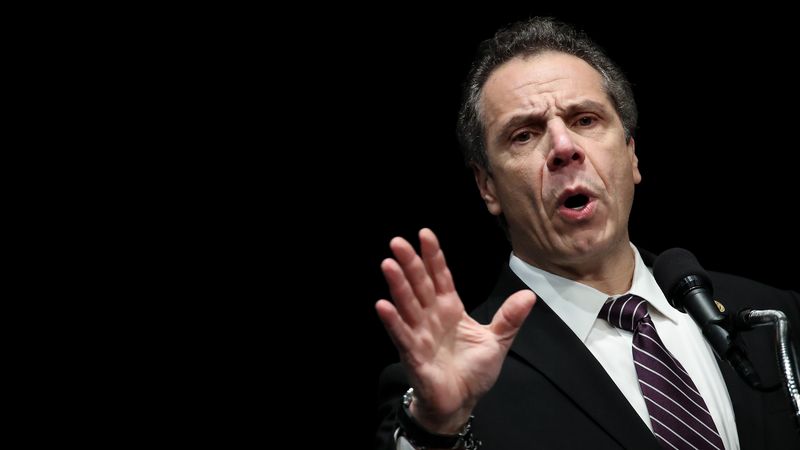Mic, May 2018
As Andrew Cuomo faces Cynthia Nixon, progressives are confronting him on voter suppression
New York Governor Andrew Cuomo is fighting to keep his job, in what is becoming one of the most contentious primary elections in the country this cycle. His challenger, actress and activist Cynthia Nixon, has turned eyes across the country to the race, and in some regards, pushed the incumbent to the left.
On April 6, Cuomo called fair elections “the backbone of our democracy,” and earlier this year in his State of the State speech, Cuomo gave a full-throated endorsement to expanding the state’s election laws, saying “at this time of citizen alienation and outrage, the best thing we can do is let people know that their voice is heard, that they matter and that they can and they should vote.”
Yet for all of his rhetoric on the subject, Cuomo has allowed New York to continue on as one of only 13 U.S. states without early voting — not to mention automatic or same-day voter registration, and the most restrictive party switch deadline in the country. For a voter to change their party, New York’s deadline is 25 days before the general election of the previous year. In 2016, this stymied voters looking to vote in the Democratic presidential primary. Now the issue is once again in the spotlight, thanks to Nixon’s primary challenge.
Unable to force a change in the party registration rules via legislation, left-wing Democratic activists, including members of the New York Progressive Action Network, are introducing a resolution at the party’s convention on May 23 and 24 which would allow the state’s 2.6 million unaffiliated voters to participate in the Democratic primary. The move is in an attempt to circumvent the combination of New York’s closed primary and its deadline to switch parties.
While the proposed rule has slim odds of garnering the two-thirds majority of delegates needed to pass, for the group of activists, the staging of such a Hail Mary is an attempt to counter the governor’s rhetoric about New York being “the most progressive state in the country.” This is to show that voter suppression is still a major issue in the Empire State.
Non-aligned voters who want to vote in the Democratic primary would have had to change their registration by Oct. 13 last year — a full 11 months in advance of the September primary.
“What [the Democratic party] is saying is, only Democrats can vote in the primary but they’re making it impossible for you to register as a Democrat if you’re an unaligned voter,” George Albro, the co-chair of the New York Progressive Action Network, said in an interview. “So that hypocrisy is what this rule change goes after.”
Erica Cohen, a member of the Brooklyn Voters Alliance, an organization devoted to expanding voting rights in New York, classified the state’s voting laws as a kind of “soft voter suppression” that makes voting more difficult than it needs to be.
“Any time people go to the polls and they’re told, ‘You can’t vote in this primary because you didn’t register correctly,’ it most likely means they won’t come back,” she said. With the state’s antiquated laws still on the books, Cohen expressed support for the resolution. “Anything that gets more people voting is good,” she said.
As is the case in many states, a primary election in New York is more consequential than a general election. This is because of the lopsided registration numbers — New York has 6.2 million registered Democrats, compared 2.8 million registered Republicans.
New York state Democratic Party Executive Director Geoff Berman has suggested the proposal would invite legal challenges it couldn’t survive if it passes, and that no party should have to open their primary unilaterally (the Republican Party holds a closed primary in New York State).
“My take on [the registration rule] is it doesn’t make a lot of sense for there to be different rules for different parties. If the state decides it wants to change its primary voting rules, it should do so uniformly so it applies equally to all political parties and all voters,” Berman said in an interview.
Albro said that, as he sees it, the case law on the rule is already settled. In the 2017 mayoral primary, for instance, the Reform Party voluntarily allowed unaffiliated voters to vote in their mayoral primary.
While Berman expressed some sympathy for voters who feel they’re locked out of an opportunity to have a say in who becomes the Democratic candidate for governor, he added that the rule exists in order to protect against “party raiding,” or the practice of members of a different party voting in a primary to influence the election.
“You have to balance people’s desire to be able to change their party registration once they become interested in voting in a particular party’s primary for some reason with the need to make sure people don’t use political gamesmanship to manipulate another party’s primary as a bad actor,” he said in an interview. “The party switching deadline has to take both of those factors into account.”
Albro dismissed the idea that this proposed rule change could lead to party raiding, as it only opens the primary up to unaffiliated voters.
Jeremy Gruber, the senior vice president of advocacy organization Open Primaries, agreed, and said that even in states with open primaries, there’s no evidence of party raiding happening on a widespread scale.
“People believe their vote matters, and they won’t use it except to express their interest in picking a preferred candidate,” he said in an interview.
Representatives for the Cuomo and Nixon campaigns did not respond to requests for comment on the proposed rule.
While NYPAN has a larger interest in opening up the primary (the group has endorsed Nixon), efforts at any kind of voting reform in New York seem reasonable when you consider the state’s abysmal turnout numbers. In the 2014 gubernatorial primary, less than 10% of eligible Democrats voted in the race between Cuomo and academic and activist Zephyr Teachout. In 2016, New York ranked 41st in the country with a 57.3% turnout rate, according to Nonprofit VOTE. That year, mass voter purges were seen before the presidential primary, and unaffiliated voters were unable to switch their registration for a primary that actually counted.
Since 2016, Cuomo has floated the idea of including some kind of voting reform in the state budget process. After early voting failed to make it through the 2017 budget, Cuomo did include funding for it in his budget proposal earlier this year. But the proposal never made it out of executive budget proposal. This is despite Cuomo highlighting it along with automatic and same-day registration in his agenda.
“This year was particularly frustrating, because it seemed like [voter reform] was actually happening,” said Asher Novek, the president of the Central Brooklyn Independent Democrats, a reform club in the borough.
Novek said he found the proposal “interesting,” especially since so many people he talks to about registering to vote don’t always realize the implications of remaining unaffiliated.
“The answer most of the time when I talk to people about registering is, ‘Oh, I’m registered but I’m unaffiliated,’ and they do that because, ‘Well I don’t want to be part of a party, I don’t want to put my name down next to something.’”
Albro added that he’s also frustrated with the state’s inaction on expanding voting rights. “When the governor wants something, he gets it,” he said, pointing to the sudden dissolution of the Independent Democratic Conference in April. He predicted that the party’s executive committee will do everything it can to kill the rule.
“The stakes are too high for them,” Albro said of the party apparatus, which progressives have argued is just an extension of the Cuomo re-election effort. However, he also said he thinks the rule change proposal will make it to a floor vote, despite slim chances of garnering the two-thirds majority it needs to pass.
Ultimately, advocates say the state’s broken voting laws do nothing but let elected officials protect their own interests.
“Voting rights isn’t a partisan issue, it has to do with more getting more people to vote,” Cohen said. “And when I meet with elected officials and you see people who are against voting reform, it becomes clear that it’s about people in power versus people not in power. People who are in power don’t want more people voicing their opinions.”

